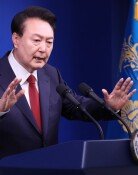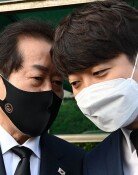ROK Aircraft Stand Watch Over Dokdo
The expression on the face of P-3C Orion patrol plane pilot Lee Jin-yong hardened as his aircraft took off at 5:40 p.m. on March 28 toward the waters off Ulleung Island in the East Sea.
Theres turbulence, with a blizzard to boot, he said.
Due to the turbulence, the aircraft shook. Black clouds on all sides severely restricted vision. Bobbing low in the sky, a huge wave threatened to swallow the P-3C.
Scrunched up behind the cockpit, this reporter broke out into a cold sweat. Lee, in charge of the safety of the crew and machine, made a decision.
Cancel the Ulleung patrol and head for Dokdo. Climb to an altitude of 5,000 feet and cruise on full throttle, Lee said.
Avoiding the rough weather, the plane ascended abruptly, but the turbulence stayed. Lee looked troubled as he said, If the Dokdo skies are this bad, we will abort the mission and go back.
Aboard the P-3C, this reporter wanted desperately to see the island claimed by Japan in commemoration of Dong-A Ilbos 86th anniversary.
Entering Dokdo airspace at 6:10 p.m., the P-3C descended slowly, cutting through the swollen clouds to reveal the faintest outline of a coast on the other side of an indigo sea. Dokdo finally came into view.
It seemed that the lone but proud island was saying, Like your ancestors before you who sacrificed their lives to protect me, so youve come, too, through the winds and blizzards to see me.
The devotion and love that Ahn Yong-bok, who single-handedly chased away the Japanese from Dokdo during the Joseon Dynasty, and the Dokdo martyrs, who fought fiercely with the Japanese who came to loot the island during the Korean War, had for Dokdo could be felt.
At that point the wind died down. The P-3C flew 300 meters off ground and circled the island to ward off Japanese patrol boats and fishing boats.
The patrol still had three hours to go. The crew ate their sack lunches hurriedly and turned to the north.
The plane approached within 10 miles of the Northern Limit Line (NLL) and activated its infrared detecting system to scan for nearby vessels. This gadget configures the shape of vessels by detecting temperature differences between water and ship.
Identify the nationality and name of your vessel, the planes crew asked of the ships in the area.
The P-3C descended to within 100 meters of the water to get a closer look.
A few North Korean ships dotted the ocean here and there. When the North Korean ships veer off course or ignore instructions, our responsive measures are taken up a notch the crew explained.
The patrol went on into the inky night. On the numerous radar screens, the type and sail route of all vessels were being tracked real-time. Thanks to the all-weather functions, the P-3C shines even at rough weathers while combat fighters or the naval vessels cannot move out.
Squadron Leader Park Il-su says, the P-3C is the only machine that patrols Korea despite foul weather, night and day. As the P-3C finished its shift, it glides onto the tarmac of Pohang base at 9:00 p.m. and the crew gives each other pats on the back.
Air-Commodore Lim Chul-soon tipped us, If the eight P-3Cs that we have are increased to 16 by the year 2010, we will be able to set up a seamless 24-hour surveillance system, no doubt about that.
Sang-Ho Yun ysh1005@donga.com
Headline News
- Korean president faces debate limitations unlike U.S. counterpart
- KEPCO's first quarter profits failed to meet market expectations
- Teenagers are left out of discussions about national pension
- 2 consultative bodies submit minutes regarding increasing number of medical students
- Woo Sang-hyuk's rivalry and friendship transcend borders







